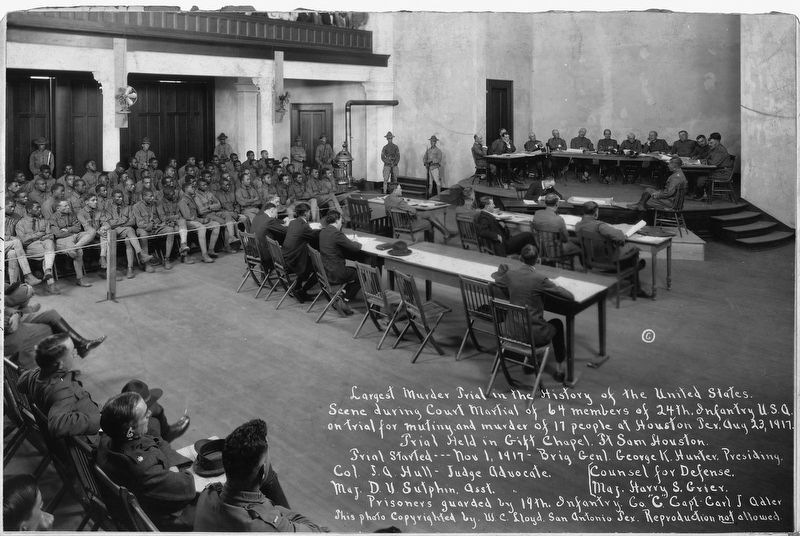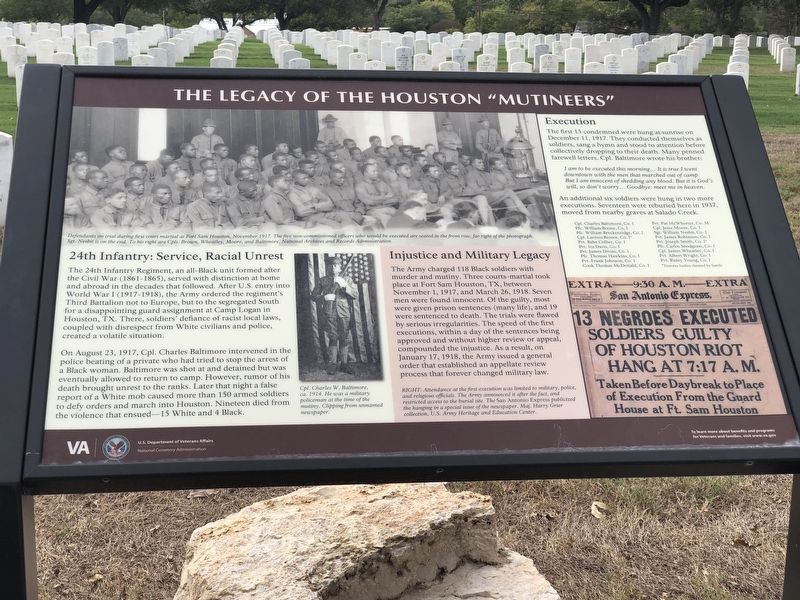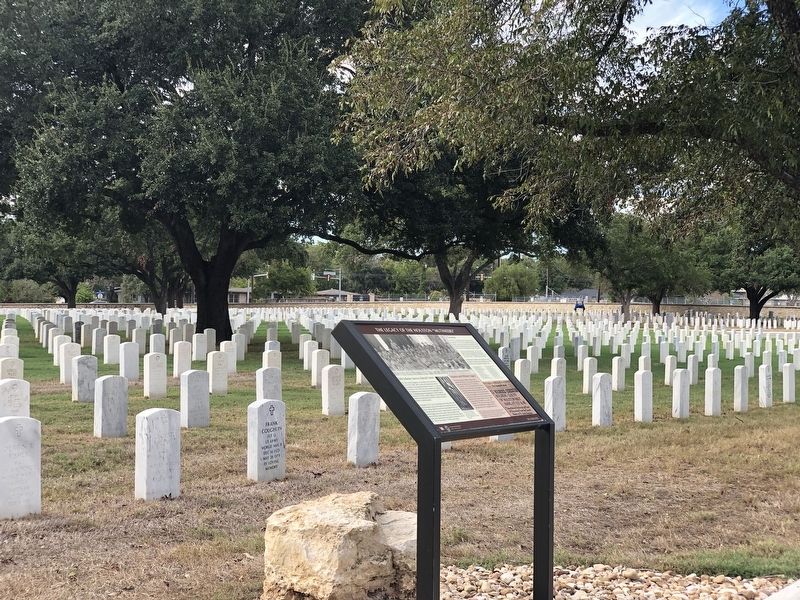Near East Side in San Antonio in Bexar County, Texas — The American South (West South Central)
The Legacy of the Houston “Mutineers”
Inscription.
24th Infantry: Service, Racial Unrest
The 24th Infantry Regiment, an all-Black unit formed after the Civil War (1861-1865), served with distinction at home and abroad in the decades that followed. After U.S. entry into World War I (1917-1918), the Army ordered the regiment's Third Battalion not to Europe, but to the segregated South for a disappointing guard assignment at Camp Logan in Houston, TX. There, soldiers' defiance of racist local laws, coupled with disrespect from White civilians and police, created a volatile situation.
On August 23, 1917, Cpl. Charles Baltimore intervened in the police beating of a private who had tried to stop the arrest of a Black woman. Baltimore was shot at and detained but was eventually allowed to return to camp. However, rumor of his death brought unrest to the ranks. Later that night a false report of a White mob caused more than 150 armed soldiers to defy orders and march into Houston. Nineteen died from the violence that ensued – 15 White and 4 Black.
Injustice and Military Legacy
The Army charged 118 Black soldiers with murder and mutiny. Three courts martial took place at Fort Sam Houston, TX, between November 1, 1917, and March 26, 1918. Seven men were found innocent. Of the guilty, most were given prison sentences (many life), and 19 were sentenced to death. The trials were flawed by serious irregularities. The speed of the first executions, within a day of the sentences being approved and without higher review or appeal, compounded the injustice. As a result, on January 17, 1918, the Army issued a general order that established an appellate review process that forever changed military law.
Execution
The first 13 condemned were hung at sunrise on December 11, 1917. They conducted themselves as soldiers, sang a hymn and stood to attention before collectively dropping to their deaths. Many penned farewell letters. Cpl. Baltimore wrote his brother:
I am to be executed this morning.… It is true I went downtown with the men that marched out of camp. But I am innocent of shedding any blood. But it is God's will, so don't worry … Goodbye: meet me in heaven.An additional six soldiers were hung in two more executions. Seventeen were reburied here in 1937, moved from nearby graves at Salado Creek.
Cpl. Charles Baltimore, Co. I • Pfc. William Boone, Co. I • Pfc. William Breckenridge, Co. I • Cpl. Larnon Brown, Co. I* • Pvt. Babe Collier, Co. I • Pvt. Ira Davis, Co. I • Pvt. James Divins, Co. I • Pfc. Thomas Hawkins, Co. I • Pvt. Frank Johnson, Co. I • Cook Thomas McDonald, Co. I • Pvt. Pat McWhorter, Co. M • Cpl. Jesse Moore, Co. I • Sgt. William Nesbit, Co. I
• Pvt. James Robinson, Co. I • Pvt. Joseph Smith, Co. I* • Pfc. Charles Snodgrass, Co. I • Cpl. James Wheatley, Co. I • Pvt. Albert Wright, Co. I • Pvt. Risley Young, Co. I (*Denotes bodies claimed by family)
[Captions]
• Top: Defendants on trial during first court martial at Fort Sam Houston, November 1917. The five non-commissioned officers who would be executed are seated in the front row, far right of the photograph. Sgt. Nesbit is on the end. To his right are Cpls. Brown, Wheatley, Moore and Baltimore. National Archives and Records Administration
• Bottom, left: Cpl. Charles W. Baltimore, ca. 1914. He was a military policeman at the time of the mutiny. Clipping from unnamed newspaper.
• Bottom, right: Attendance at the first execution was limited to military, police, and religious officials. The Army announced it after the fact, and restricted access to the burial site. The San Antonio Express publicized the hanging in a special issue of the newspaper. Maj. Harry Grier collection, U.S. Army Heritage and Education Center
Erected 2022 by U.S. Department of Veterans Affairs, National Cemetery Administration.
Topics. This historical marker is listed in these topic lists: African Americans

W.C. Lloyd via National Archives and Records Administration (Public Domain), 1917
3. Court Martial Scene
During the first court martial, held in Fort Sam Houston's Griff Chapel, 64 soldiers from the 24th U.S. Infantry Regiment's 3rd Battalion (seated under balcony at left) stood trial on charges of disobeying orders, mutiny, murder and aggravated assault.
Location. 29° 28.642′ N, 98° 25.935′ W. Marker is in San Antonio, Texas, in Bexar County. It is in the Near East Side. Marker is on Macodonio Street north of San Antonio Boulevard, on the left when traveling north. Marker is in Fort Sam Houston National Cemetery. Touch for map. Marker is at or near this postal address: 1520 Harry Wurzbach Rd, San Antonio TX 78209, United States of America. Touch for directions.
Other nearby markers. At least 8 other markers are within 3 miles of this marker, measured as the crow flies. Dodd Field (Fort Sam Houston) Enemy Alien Detention Station, World War II (about 600 feet away, measured in a direct line); The Battle of the Salado (approx. 1.1 miles away); The Dawson Massacre (approx. 1.6 miles away); Dawson Massacre Memorial (approx. 1.6 miles away); Motherhouse Chapel (approx. 2 miles away); Motherhouse (approx. 2.1 miles away); Incarnate Word College (approx. 2.1 miles away); Brackenridge Villa Memorial (approx. 2.1 miles away). Touch for a list and map of all markers in San Antonio.
Also see . . .
1. The 1917 Houston Riots/Camp Logan Mutiny. Prairie View A&M University website entry:
The episode has the ignominious distinction of being the only race riot in U.S. history where more whites then blacks were killed, and it also resulted in both the largest murder trial and the largest court martial in U.S. history. (Submitted on October 29, 2023, by Duane and Tracy Marsteller of Murfreesboro, Tennessee.)
2. Houston Riot of 1917. Handbook of Texas website entry:
In the spring of 1917, the War Department ordered two military installations built in Harris County – Camp Logan and Ellington Field. The Illinois National Guard was to train at Camp Logan, located on the northwest outskirts of the city. To guard the construction site, on July 27, 1917, the army ordered the Third Battalion of the Black Twenty-fourth United States Infantry to travel by train with seven White officers from the regimental encampment at Columbus, New Mexico, to Houston. (Submitted on October 29, 2023, by Duane and Tracy Marsteller of Murfreesboro, Tennessee.)
3. Houston Mutiny and Riot Records. South Texas College of Law website entry:
Collection of digitized newspaper clippings, witness statements, court records and other documents relating to the violent episode and the courts martial that followed. (Submitted on October 29, 2023, by Duane and Tracy Marsteller of Murfreesboro, Tennessee.)
Credits. This page was last revised on November 13, 2023. It was originally submitted on October 28, 2023, by Duane and Tracy Marsteller of Murfreesboro, Tennessee. This page has been viewed 126 times since then and 67 times this year. Photos: 1, 2. submitted on October 28, 2023, by Duane and Tracy Marsteller of Murfreesboro, Tennessee. 3. submitted on October 29, 2023, by Duane and Tracy Marsteller of Murfreesboro, Tennessee.

